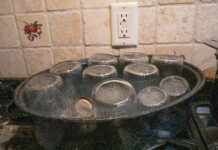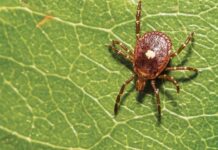Last week’s Farming 101 covered dangerous gases that farmers can be exposed to. This week, we continue airborne hazards with mold, dust, chemicals, pesticides and fumes.

1Molds
Can occur in hay, bedding, spoiled silage or grain. Mold spores in grains and silage attach to dust, are absorbed through inhalation and affect the lungs. Wear dust/mist respirator when handling moldy hay, grain and silage.
2Dusts
Found in confinement buildings, fields, grinding and conveying feed and silage, animal hair, skin and wastes. Dust is absorbed through inhalation, has no direct symptoms but may aggravate existing lung conditions and cause lung problems after long exposure. Provide adequate ventilation and use approved dust/mist respirator.
3Disinfectants
Power washing animal confinement buildings for extended periods could cause inhalation of chemicals. Chlorine, absorbed through inhalation, affects skin and swallowing, causes irritation of eyes, nose, mouth, headache, dizziness, nausea, coughing and wheezing. Use a respirator with appropriate chemical cartridge and filter, goggles, gloves, protective suit and rubber boots when handling this chemical.
Organic vapors, vapors, and mists absorbed through inhalation affect skin and swallowing. Causes irritation of eyes, nose, mouth, headache, dizziness, nausea, coughing and wheezing, and can affect liver, kidney and central nervous system. Wear appropriate protective clothing, gloves, eyewear and use respirator with organic vapor cartridge and pre-filter, goggles, gloves, protective suit and rubber boots.
4Pesticides
The greatest danger is diluting or mixing concentrates — a potential danger associated with the application of product by spraying, rubbing or other contact.
Symptoms vary with a specific agent but may cause lung damage and systemic poisoning. Use a respirator with appropriate pesticide cartridge (organic vapor cartridge and pre-filter), chemical goggles and protective clothing. Read the label for other personal protective requirements.
5Fumigation of seeds
Fumigants can be liquid mist or gas/vapor, absorbed through inhalation and some skin absorption. Symptoms vary. Adhere to re-entry times after fumigant release (printed on the label) and provide adequate mechanical or natural ventilation, wear protective clothing, gloves, eye protection and respirator as specified on the label, use an air-supplied respirator if fumigant does not have adequate warning properties (i.e., odor).
6Fumes
Metal fumes can be absorbed through inhalation during welding of certain aluminum, galvanized or stainless steel; soldering and metal pouring. Small particles penetrate to a deep part of the lungs. Can cause eye irritation, dizziness, nausea, “metal fume fever.” Provide adequate ventilation, wear approved respirator and monitor exposure.
Sources: Colorado State University Cooperative Extension, Agricultural airborne hazards.
(Farm and Dairy is featuring a series of “101” columns throughout the year to help young and beginning farmers master farm living. From finances to management to machinery repair and animal care, farmers do it all.)
More Farming 101 columns:
- 5 airborne hazards to beware of on the farm
- 5 things to know about Wagyu beef
- Pennsylvania utility vehicle laws
- Ohio utility vehicle laws
- Farm chemical safety checklist
- When should a farm become a business entity?
- Harvest prep: Check your yield monitors
- How to tag livestock properly
- 6 tips for decision making on a family farm
- 8 tips to prepare your farm for agritourism
- How to plan for farm emergencies
- 7 keys to success on the farm
- 7 tips for healthy fair animals
- 5 tips to ensure livestock health before the fair
- 6 tips to keep your livestock parasite free
- 6 tips for vaccinating your livestock
- 5 tips to prevent dairy cow foot problems
- 6 common foot problems found in dairy cows
- Recognize, prevent heat stress in dairy cattle
- How to monitor your dairy herd
- How to start your own dairy farm
- 5 tips for sun safety in the field
- Employing youth for the summer
- What to do if a hay fire occurs
- How to prevent hay fires
- How to extend the life of your fence
- 10 safety tips for installing electric fences
- How to chose the right fence for your farm
- How to create a fencing plan
- 7 steps for easy sprayer calibration
- Prepare for planting season, Part 2: Calibration
- Prepare for planting season, Part 1: The Basics
- 7 tips to improve security on your farm
- 5 tips to protect your farmland
- 3 measures to deal with severe farm debt
- How to buy time to catch up on farm debt
- 6 tips to manage income on the farm
- 5 tips to recognize and deal with farm stress
- How to prepare a livestock birthing kit
- 5 tips for marketing your farm
- How to develop farm mission, vision statements
- 5 tips for setting farm goals
- 2 types of livestock insurance policies
- 6 things you need to know about WFRP plans
- 3 basics of crop insurance
- How does liability insurance work on the farm?
- Why do I need farm insurance?
- How to understand and use Ohio’s CAUV
- How to utilize the Pa. Clean and Green Act
- 9 tips for filing farm taxes
- 8 reasons record keeping for taxes is essential
- 5 tips for post-harvest storage
- 7 tips for family meetings on the farm
- 4 tips for balancing your farm and family
- 4 tips for communicating on the family farm
- 4 tips for firing an employee
- 6 tips for keeping good farm help
- 4 tips for recruiting farm labor
- 5 general farm labor laws
- 4 tips for employing minors
- 4 tips for PTO safety
- 5 things young farmers should know about finances
- The farm balance sheet
- 5 items for your farm’s cash flow statement
- Personal and business records: Keep them separate
- What to include in your farm business plan
- How to approach a lender: Tips for getting a farm loan
- How to use microloans to get your farm started
- Saving for the future: 6 tips for young farmers
- How to create a farm safety kit
- 5 tips for child safety on the farm
- 4 tips for transporting livestock
- 5 ways to better understand tractor stability
- 6 farm equipment hacks












